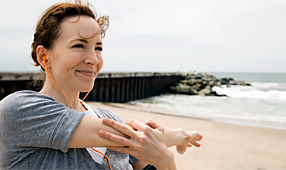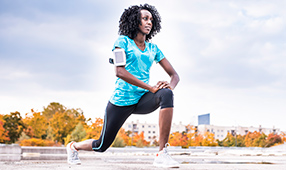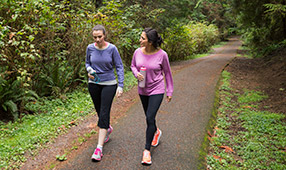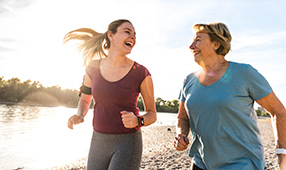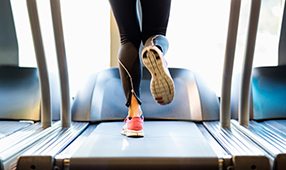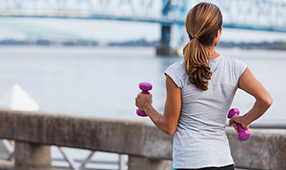Key takeaways
- Prolonged standing stresses your legs, knees and lower back, as well as can lead to varicose veins, joint damage and circulation issues.
- Here are five strategies to minimize pain.
It’s no secret standing all day wreaks havoc on your joints, ligaments and aching feet. Now a growing body of research suggests it may also increase your risk for chronic disease.
“Being still whether sitting or standing, impacts our metabolism and circulation, both of which can contribute to certain conditions and diseases,” says Jennifer Spreckley, director and chief learning officer of Kingsway Pilates. Indeed, studies show prolonged standing not only stresses your legs, knees and lower back, it can also lead to varicose veins, joint damage and circulation issues.
While you need to be on your feet to teach, you can incorporate strategies to ease the strain. You may already know it’s important to maintain good posture, move around and give your feet room to breathe. Here, five additional strategies to quiet barking dogs and minimize pain.
1. Feet first! Since your feet are the weight-bearing foundation of your body, selecting supportive footwear is key. According to Paul Salinas, Doctor of Chiropractic and Certified Chiropractic Sports Physician at Park Avenue Spine in New York, shoes that wear like sneakers with added support and cushioning are your best bet. Dansko, for example, famously designs shoes specifically for the upright subset featuring strong arch support, roomy toe boxes, high-quality leathers that follow the natural contours of the foot. In fact, according to Dansko’s director of Brand Marketing and Communication, Matt DewWitte, the “rocker bottom” on the company’s stapled clog collections follow the natural contour of the foot, providing shock absorption comparable to athletic shoes. “When worn over extended periods, this rocker bottom reduces fatigue on the feet, legs and back,” he says.
Dansko isn’t the only company designing shoes to meet the demands of employees who spend most of the day on their feet. Aetrex, for example, produces orthotic shoes with a focus on fashion, function and quality. The company builds a unique Lynco orthotic system into every shoe, offering comfort, support and proper body alignment. A bonus: All of their shoes come equipped with memory foam cushioning and advanced odor free technology.
2. Mind your posture. Most of us stand without thinking too much about it. But being mindful of your stance can make a world of difference. Wearing the right footwear helps keep your joints stacked directly on top of one another, so your bones can support your body weight instead of the soft tissues of the body, provided you take care to stack your hips over your ankles. “It’s common to stand with your hips jutting out in front of you, which prevents your core musculature from being able to kick in and support you,” says Kate Hanley, yoga teacher, author of “A Year of Daily Calm” and founder of MsMindBody.com. “You want to feel most of the weight of the body in your heels—imagine a plumb line from your ears to your feet, and you will likely have to lean your weight backward to bring your hips in to that line. Then, imagine your head is a balloon and let it float up to the ceiling so that the string—your spine—can unkink and stretch to its full length. This will reduce tension in your neck and shoulders.”
3. Shake things up. Sit down, stretch, move—literally throw your weight around, but try to avoid standing or sitting in the same position for hours at a time. In fact, most experts agree you should limit continuous standing to one hour per day and cumulative standing to four hours per day. Since that may not be possible, it’s important to do what you can to give your joints and muscles a recess. “Instead of standing in one posture, incorporate as many different types of movement into your daily routine as you can,” says Hanley. Have to stay still? Salinas recommends shifting the weight distribution on you feet. Stretch your calves, move your ankles and alternately flex and point your feet.
4. Roll around. Use props to help ease pressure spots. “Keep a self-care kit in your desk with a foam roller, tennis ball, lacrosse ball and a bakery rolling pin so you can roll out your muscles in between classes,” suggests Salinas. Need instant relief when you’re at the front of the class? Tap your toes, stretch your calves or break out your tennis ball and roll your feet beneath your desk. The key, say experts, is paying attention to your body’s cues to quiet muscle pain and strain.
5. Take a recess. Whether you run on the blacktop, walk to the restroom or get outside for a five-minute change-of-scenery breather, taking breaks throughout the day is necessary to stave off postural pain. “Breathing from the diaphragm as opposed to chest breathing helps strengthen your posture and also helps alleviate classroom stress,” says Salinas. Then, at the end of the day, massage your feet. Lacing your fingers between your toes to spread the toes can help to promote blood flow and balance your foot muscles. No time for a rubdown? Try a product such as Happy Feet Socks or use pedicure toe spacers to stretch out your tootsies.
Stretch it out!
Want to feel better fast? These stretches can help relieve postural pain in a snap.
Top of the foot stretch: Standing, shift the weight to one foot and extend the hip of the stretching leg behind the body placing the top of the foot and toes on to the floor. You may want to stand with support for the first try as this can produce a lot of sensation.
Calf stretch: Use a rolled up towel, mat, 1/2 foam dome, the low side of a yoga block or any prop of similar height. Step the ball of the foot onto the prop, leaving the heel on the floor. (The stretching leg should be straight not locked.)
Shoulder stretch: Stand facing a wall. Place your palms on the wall shoulder width apart with the elbows in the same track as the hands and shoulders. Pretend there is a bar between the elbows so they don’t widen as you move into the stretch. Walk the feet a little away from the wall to create space for the head to drop through your arms. Keep your spine neutral and bend your knees if there is tension in the low back.


